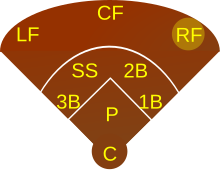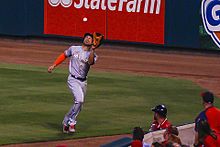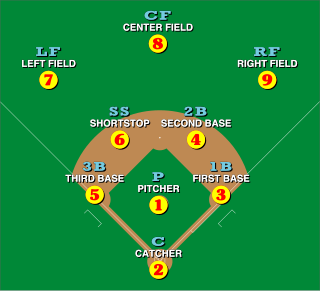
In the sport of baseball, each of the nine players on a team is assigned a particular fielding position when it is their turn to play defense. Each position conventionally has an associated number, for use in scorekeeping by the official scorer: 1 (pitcher), 2 (catcher), 3, 4, 5, 6 (shortstop), 7, 8, and 9. Collectively, these positions are usually grouped into three groups: the outfield, the infield, and the battery. Traditionally, players within each group will often be more able to exchange positions easily ; however, the pitcher and catcher are highly specialized positions and rarely will play at other positions.

Softball is a game similar to baseball played with a larger ball on a smaller field, with only underhand pitches permitted. Softball is played competitively at club levels, the college level, and the professional level. The game was first created in 1887 in Chicago by George Hancock.

In baseball and softball statistics, an error is an act, in the judgment of the official scorer, of a fielder misplaying a ball in a manner that allows a batter or baserunner to advance one or more bases or allows a plate appearance to continue after the batter should have been put out. The term error is sometimes used to refer to the play during which an error was committed.

Catcher is a position in baseball and softball. When a batter takes their turn to hit, the catcher crouches behind home plate, in front of the (home) umpire, and receives the ball from the pitcher. In addition to this primary duty, the catcher is also called upon to master many other skills in order to field the position well. The role of the catcher is similar to that of the wicket-keeper in cricket.

A first baseman, abbreviated 1B, is the player on a baseball or softball team who fields the area nearest first base, the first of four bases a baserunner must touch in succession to score a run. The first baseman is responsible for the majority of plays made at that base. In the numbering system used to record defensive plays, the first baseman is assigned the number 3.
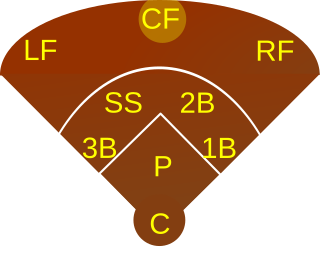
A center fielder, abbreviated CF, is the outfielder in baseball who plays defense in center field – the baseball and softball fielding position between left field and right field. In the numbering system used to record defensive plays, the center fielder is assigned the number 8.

Throughout the history of baseball the rules have frequently changed as the game has continued to evolve. The rules of baseball can vary slightly from league to league, with there being dozens of leagues worldwide. A few common rules most professional leagues have in common is that 4 balls is a Base on balls, 3 strikes is a strikeout and 3 outs ends a half inning. One example of differing rules in professional leagues is in Major League Baseball a pitch clock is in place to speed up the pace of the game by forcing pitchers to pitch in a 15-20 second window, where in the Nippon Professional Baseball League no such rule exists.

A baseball field, also called a ball field or baseball diamond, is the field upon which the game of baseball is played. The term can also be used as a metonym for a baseball park. The term sandlot is sometimes used, although this usually refers to less organized venues for activities like sandlot ball.
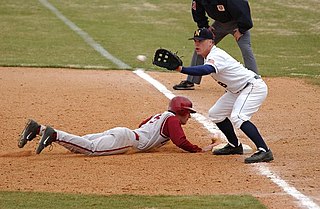
In baseball, part of the infielders' and pitcher's jobs is to cover bases. That is, they stand next to a base in anticipation of receiving the ball thrown from another fielder, so that they may make a play on an opposing baserunner who is approaching that base. On a force play, the fielder covering the base stands with one foot on that base.

In the sports of baseball and softball, a batted ball is a pitch that has been contacted by the batter's bat. Batted balls are either fair or foul, and can be characterized as a fly ball, pop-up, line drive, or ground ball. In baseball, a foul ball counts as a strike against the batter, unless there are already two strikes on the batter, with special rules applying to foul tips and foul bunts. Fly balls are those hit in an arcing manner, with pop-ups being a subset of foul balls that do not travel far. Line drives are batted balls hit on a straight line trajectory, while ground balls are hit at a low trajectory, contact the ground shortly after being hit, and then either roll or bounce. Batted balls, especially line drives, can present a hazard to players, umpires, and spectators, as people have been seriously injured or killed after being struck by batted balls.

Baseball scorekeeping is the practice of recording the details of a baseball game as it unfolds. Professional baseball leagues hire official scorers to keep an official record of each game, but many fans keep score as well for their own enjoyment. Scorekeeping is usually done on a printed scorecard and, while official scorers must adhere precisely to one of the few different scorekeeping notations, most fans exercise some amount of creativity and adopt their own symbols and styles.
This is an alphabetical list of selected unofficial and specialized terms, phrases, and other jargon used in baseball, along with their definitions, including illustrative examples for many entries.
